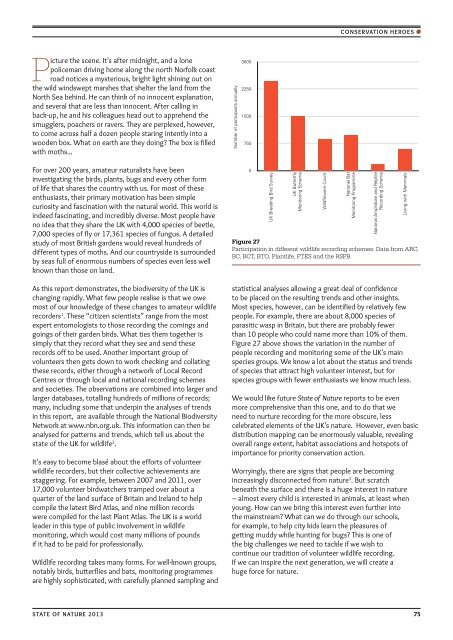State of Nature report - RSPB
State of Nature report - RSPB
State of Nature report - RSPB
Create successful ePaper yourself
Turn your PDF publications into a flip-book with our unique Google optimized e-Paper software.
CONSERVATION HEROES<br />
Picture the scene. It’s after midnight, and a lone<br />
policeman driving home along the north Norfolk coast<br />
road notices a mysterious, bright light shining out on<br />
the wild windswept marshes that shelter the land from the<br />
North Sea behind. He can think <strong>of</strong> no innocent explanation,<br />
and several that are less than innocent. After calling in<br />
back-up, he and his colleagues head out to apprehend the<br />
smugglers, poachers or ravers. They are perplexed, however,<br />
to come across half a dozen people staring intently into a<br />
wooden box. What on earth are they doing? The box is filled<br />
with moths...<br />
For over 200 years, amateur naturalists have been<br />
investigating the birds, plants, bugs and every other form<br />
<strong>of</strong> life that shares the country with us. For most <strong>of</strong> these<br />
enthusiasts, their primary motivation has been simple<br />
curiosity and fascination with the natural world. This world is<br />
indeed fascinating, and incredibly diverse. Most people have<br />
no idea that they share the UK with 4,000 species <strong>of</strong> beetle,<br />
7,000 species <strong>of</strong> fly or 17,361 species <strong>of</strong> fungus. A detailed<br />
study <strong>of</strong> most British gardens would reveal hundreds <strong>of</strong><br />
different types <strong>of</strong> moths. And our countryside is surrounded<br />
by seas full <strong>of</strong> enormous numbers <strong>of</strong> species even less well<br />
known than those on land.<br />
As this <strong>report</strong> demonstrates, the biodiversity <strong>of</strong> the UK is<br />
changing rapidly. What few people realise is that we owe<br />
most <strong>of</strong> our knowledge <strong>of</strong> these changes to amateur wildlife<br />
recorders 1 . These “citizen scientists” range from the most<br />
expert entomologists to those recording the comings and<br />
goings <strong>of</strong> their garden birds. What ties them together is<br />
simply that they record what they see and send these<br />
records <strong>of</strong>f to be used. Another important group <strong>of</strong><br />
volunteers then gets down to work checking and collating<br />
these records, either through a network <strong>of</strong> Local Record<br />
Centres or through local and national recording schemes<br />
and societies. The observations are combined into larger and<br />
larger databases, totalling hundreds <strong>of</strong> millions <strong>of</strong> records;<br />
many, including some that underpin the analyses <strong>of</strong> trends<br />
in this <strong>report</strong>, are available through the National Biodiversity<br />
Network at www.nbn.org.uk. This information can then be<br />
analysed for patterns and trends, which tell us about the<br />
state <strong>of</strong> the UK for wildlife 2 .<br />
It’s easy to become blasé about the efforts <strong>of</strong> volunteer<br />
wildlife recorders, but their collective achievements are<br />
staggering. For example, between 2007 and 2011, over<br />
17,000 volunteer birdwatchers tramped over about a<br />
quarter <strong>of</strong> the land surface <strong>of</strong> Britain and Ireland to help<br />
compile the latest Bird Atlas, and nine million records<br />
were compiled for the last Plant Atlas. The UK is a world<br />
leader in this type <strong>of</strong> public involvement in wildlife<br />
monitoring, which would cost many millions <strong>of</strong> pounds<br />
if it had to be paid for pr<strong>of</strong>essionally.<br />
Wildlife recording takes many forms. For well-known groups,<br />
notably birds, butterflies and bats, monitoring programmes<br />
are highly sophisticated, with carefully planned sampling and<br />
Number <strong>of</strong> participants annually<br />
3000<br />
2250<br />
1500<br />
750<br />
0<br />
UK Breeding Bird Survey<br />
UK Butterfly<br />
Monitoring Scheme<br />
Figure 27<br />
Participation in different wildlife recording schemes. Data from ARC,<br />
BC, BCT, BTO, Plantlife, PTES and the <strong>RSPB</strong>.<br />
statistical analyses allowing a great deal <strong>of</strong> confidence<br />
to be placed on the resulting trends and other insights.<br />
Most species, however, can be identified by relatively few<br />
people. For example, there are about 8,000 species <strong>of</strong><br />
parasitic wasp in Britain, but there are probably fewer<br />
than 10 people who could name more than 10% <strong>of</strong> them.<br />
Figure 27 above shows the variation in the number <strong>of</strong><br />
people recording and monitoring some <strong>of</strong> the UK’s main<br />
species groups. We know a lot about the status and trends<br />
<strong>of</strong> species that attract high volunteer interest, but for<br />
species groups with fewer enthusiasts we know much less.<br />
We would like future <strong>State</strong> <strong>of</strong> <strong>Nature</strong> <strong>report</strong>s to be even<br />
more comprehensive than this one, and to do that we<br />
need to nurture recording for the more obscure, less<br />
celebrated elements <strong>of</strong> the UK’s nature. However, even basic<br />
distribution mapping can be enormously valuable, revealing<br />
overall range extent, habitat associations and hotspots <strong>of</strong><br />
importance for priority conservation action.<br />
Worryingly, there are signs that people are becoming<br />
increasingly disconnected from nature 3 . But scratch<br />
beneath the surface and there is a huge interest in nature<br />
– almost every child is interested in animals, at least when<br />
young. How can we bring this interest even further into<br />
the mainstream? What can we do through our schools,<br />
for example, to help city kids learn the pleasures <strong>of</strong><br />
getting muddy while hunting for bugs? This is one <strong>of</strong><br />
the big challenges we need to tackle if we wish to<br />
continue our tradition <strong>of</strong> volunteer wildlife recording.<br />
If we can inspire the next generation, we will create a<br />
huge force for nature.<br />
Wildflowers Count<br />
National Bat<br />
Monitoring Programme<br />
National Amphibian and Reptile<br />
Recording Scheme<br />
Living with Mammals<br />
STATE OF NATURE 2013 75

















